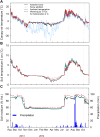Fast Responses of Root Dynamics to Increased Snow Deposition and Summer Air Temperature in an Arctic Wetland
- PMID: 30214452
- PMCID: PMC6125414
- DOI: 10.3389/fpls.2018.01258
Fast Responses of Root Dynamics to Increased Snow Deposition and Summer Air Temperature in an Arctic Wetland
Abstract
In wet tundra ecosystems, covering vast areas of the Arctic, the belowground plant biomass exceeds the aboveground, making root dynamics a crucial component of the nutrient cycling and the carbon (C) budget of the Arctic. In response to the projected climatic scenarios for the Arctic, namely increased temperature and changes in precipitation patterns, root dynamics may be altered leading to significant changes in the net ecosystem C budget. Here, we quantify the single and combined effects of 1 year of increased winter snow deposition by snow fences and summer warming by open-top chambers (OTCs) on root dynamics in a wetland at Disko Island (West Greenland). Based on ingrowth bags, snow accumulation decreased root productivity by 42% in the 0-15 cm soil depth compared to ambient conditions. Over the growing season 2014, minirhizotron observations showed that root growth continued until mid-September in all treatments, and it peaked between the end of July and mid-August. During the season, plots exposed to experimental warming showed a significant increase in root number during September (between 39 and 53%) and a 39% increase in root length by the beginning of September. In addition, a significant reduction of root diameter (14%) was observed in plots with increased snow accumulation. Along the soil profile (0-40 cm) summer warming by OTCs significantly increased the total root length (54%), root number (41%) and the root growth in the 20-30 cm soil depth (71%). These results indicate a fast response of this ecosystem to changes in air temperature and precipitation. Hence, on a short-term, summer warming may lead to increased root depth and belowground C allocation, whereas increased winter snow precipitation may reduce root production or favor specific plant species by means of reduced growing season length or increased nutrient cycling. Knowledge on belowground root dynamics is therefore critical to improve the estimation of the C balance of the Arctic.
Keywords: arctic tundra; minirhizotrons; open top chambers (OTC); root dynamics; snow fence; warming; wetland.
Figures






References
-
- Arndal M. F., Tolver A., Larsen K. S., Beier C., Schmidt I. K. (2017). Fine root growth and vertical distribution in response to elevated co2, warming and drought in a mixed heathland–grassland. Ecosystems 1–16, 15–30. 10.1007/s10021-017-0131-2 - DOI
-
- Berendse F., Aerts R. (1987). Nitrogen-use-efficiency: a biologically meaningful definition? Funct. Ecol. 1 293–296.
LinkOut - more resources
Full Text Sources
Other Literature Sources

